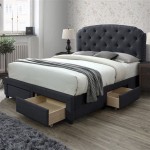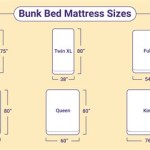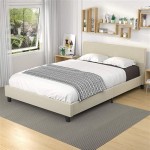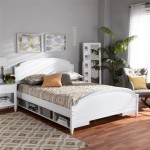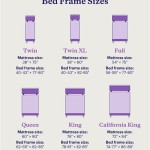Half A King Size Bed: Exploring Dimensions, Applications, and Alternatives
The term "half a king-size bed" lacks a universally accepted definition, leading to variations in its practical application and interpretation. This article will explore different interpretations of the term, examine potential uses for a bed of this size, and consider available alternatives. Understanding the dimensions and purpose behind the concept helps in determining whether it suits specific needs and spatial constraints.
The absence of a standard definition necessitates a careful analysis of what the term might imply. One practical interpretation involves halving the width of a standard king-size mattress. Another interpretation might suggest creating a custom-sized mattress that offers a comparable sleeping surface to half of a king-size bed when combined with another unit to form a whole. Each interpretation yields unique benefits and drawbacks depending on room size, user needs, and intended applications.
To fully understand the concept, it is necessary to consider the dimensions of a standard king-size bed. A standard king-size mattress typically measures 76 inches wide and 80 inches long. Halving the width yields a dimension of approximately 38 inches. Hence, one interpretation of "half a king-size bed" would be a mattress that is 38 inches wide and 80 inches long. This dimension is similar to that of a twin-size bed, which is typically 38 inches wide and 75 inches long. However, the 5-inch difference in length highlights a subtle variation affecting overall comfort, particularly for taller individuals.
Another approach involves a custom-made mattress designed for modular use. This concept envisions two identical units, each potentially slightly wider than a standard twin, that can be placed side-by-side to form a complete king-size bed. The advantage here lies in the flexibility of configuration. These individual units can be used separately as single beds or joined to create a larger sleeping surface as needed. The specific dimensions of each half would depend on the manufacturer's design, aiming to achieve the standard king-size dimensions when combined.
Potential Applications of Half a King-Size Bed
The applications of a bed approximating half the size of a king-size vary depending on its dimensions and target user. In situations where space is limited, a 38-inch wide mattress offers a viable sleeping solution without compromising excessively on length. This is particularly relevant in small apartments, dorm rooms, or guest rooms where maximizing floor space is a priority.
The modular approach, where two units combine to form a king-size bed, is advantageous in situations requiring adaptable sleeping arrangements. Guest rooms can benefit greatly from this arrangement. During periods with single occupants, the beds can be separated, providing more flexible use of the room. When couples or families visit, the beds can be joined seamlessly to create a king-size sleeping surface.
Another potential application is for individuals who prefer a more enclosed sleeping environment. Some people find comfort in the narrower confines of a twin or half-king bed. This is often a matter of personal preference and may contribute to a feeling of security and improved sleep quality which is especially beneficial if the room is oversized and empty.
The Role of Bed Frames and Support Systems
Regardless of the specific dimensions chosen for the "half a king-size bed," selecting an appropriate bed frame and support system is essential for ensuring both comfort and mattress longevity. If the mattress is dimensionally equivalent to a twin-size bed, a standard twin-size bed frame will suffice. However, if custom dimensions are involved, a custom-made bed frame or a platform bed may be necessary to provide adequate support.
For modular systems, the bed frame design plays a crucial role in facilitating seamless joining and separation. Some manufacturers offer bed frames specifically designed for these types of mattresses, incorporating features like interlocking mechanisms that ensure stability and prevent slippage when the beds are connected. It is vital to ensure the chosen frame provides adequate support across the entire mattress surface, preventing sagging and uneven weight distribution.
In addition to the frame itself, the type of support system used within the frame is also a significant factor. Options include traditional box springs, platform beds with slats, and adjustable bases. The choice should reflect the type of mattress being used and the desired level of support. Platform beds with closely spaced slats are generally recommended for memory foam mattresses, while box springs can provide additional cushioning and support for innerspring mattresses.
Alternatives to Consider
Before opting for a "half a king-size bed," it is worthwhile to consider other available mattress sizes and sleeping arrangements. A twin XL mattress, measuring 38 inches wide and 80 inches long, offers the same width as a standard twin but provides five additional inches of length, catering to taller individuals. This can be a suitable alternative in situations where length is a primary concern.
A full-size mattress, measuring 54 inches wide and 75 inches long, provides significantly more width than a half-king or twin mattress. While shorter than a king-size, it may be a more comfortable option for individuals who prefer more sleeping space but lack the room for a larger bed. This is a common choice for single adults who desire more space than a twin bed offers but don't need the expansive area of a queen or king.
Another alternative is the use of daybeds or futons. These versatile pieces of furniture can serve as seating during the day and transform into a sleeping surface at night. Daybeds typically accommodate a twin-size mattress, while futons are available in various sizes, including full and queen. These options offer flexibility in smaller spaces, providing a dual-purpose solution.
Moreover, the exploration of adjustable beds presents an interesting alternative. While not altering the standard bed size, an adjustable base allows for customized sleep positions. This could potentially mitigate the need for a custom "half king" arrangement if the goal is to enhance individual comfort and support.
Ultimately, the decision to pursue a "half a king-size bed," or an alternative solution, should be based on a careful assessment of individual needs, spatial constraints, and intended use. Each option offers unique advantages and drawbacks, and a thorough comparison is crucial for making an informed decision.

Half King Size Mandala Bed Headboard Manusa

Flex Top Split King Sheets 600 Thread Count Blue By Royal Tradition

Aico Grand Masterpiece King Half Tester Bed 7 Pc In Royal Sienna 905

Half Fold Metal Box Spring King Size Mattress Bed Foundation Platform

Heritage Half Poster Bed

Flex Top Split King Sheets 600 Thread Count Blue By Royal Tradition

Sizing Chart Chilipad Cooling Mattress Pad

Top Split King Sheets Sets For Adjustable Beds Half Sheet 21 Deep Pocket 32 800tc 100 Cotton Fitted White Solid

Esparanza Brown Cherry California King Upholstered Panel Bed By Furniture Of America Cm7478ch Ck Traditional Style Eco Leather Resin Wood

Jaylen King Bed B9270 K

